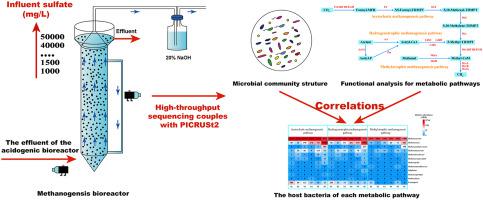Journal of Cleaner Production ( IF 9.7 ) Pub Date : 2022-06-23 , DOI: 10.1016/j.jclepro.2022.132829 Jun Li , Ai-Min Li , Yan Li , Min-Hui Cai , Duan-Hao Wang , Ye-Chao Tian , Ji Wu , Zheng Wang , Li-Qun Xing , Quan-Xing Zhang

|
In this study, a lab-scale bioreactor was built to investigate the influence of sulfate on the overall performance, microbial community, and metabolic pathways in the methanogenic bioreactor of a two-phase anaerobic digestion system. The results demonstrated that by gradually cultivating the sludge of the methanogenic bioreactor, a chemical oxygen demand (COD) degradation efficiency of over 65% was achieved for sulfate contents from 10,000 mg/L to 30,000 mg/L. The sulfate reduction performance could only be maintained at a high level for influent COD/sulfate ratios no less than 1.88. In addition, the methane production rate (MPR) decreased from 0.92 L/L/d to 0.28 L/L/d, and the proportion of methane in biogas dropped from 51% to 33% when the influent sulfate exceeded 30,000 mg/L. High-throughput sequencing coupled with PICRUSt2 revealed that the dissimilatory sulfate process could be enhanced by sulfate within 30,000 mg/L. While an amount of greater than 5000 mg/L sulfate remarkably inhibited the assimilatory sulfate reduction process, and this inhibition was induced by the down-regulation of the cysNC, cysC, cysI and cysJ genes. For the methanogenic process, sulfate contents within 30,000 mg/L had no obvious impact on all of the acetoclastic, hydrogenotrophic, and methylotrophic methanogenesis processes, but serious suppression was observed for sulfate amounts greater than 30,000 mg/L. This inhibition primarily originated from the decrease in mcrA, mcrB, and mcrG genes that regulate the conversion of methylcoenzyme M to methane, the last step of all three methanogenesis pathways.
中文翻译:

两相厌氧消化系统产甲烷生物反应器的系统性能和功能分析:进水硫酸盐的影响
在这项研究中,建立了一个实验室规模的生物反应器,以研究硫酸盐对两相厌氧消化系统的产甲烷生物反应器的整体性能、微生物群落和代谢途径的影响。结果表明,通过逐步培养产甲烷生物反应器的污泥,化学需氧量(COD) 降解效率超过 65%,硫酸盐含量从 10,000 mg/L 到 30,000 mg/L。只有当进水 COD/硫酸盐比率不低于 1.88 时,硫酸盐还原性能才能维持在较高水平。此外,当进水硫酸盐超过30,000 mg/L时,甲烷产率(MPR)从0.92 L/L/d下降到0.28 L/L/d,沼气中的甲烷比例从51%下降到33%。高通量测序与 PICRUSt2 结合显示,30,000 mg/L 以内的硫酸盐可以增强异化硫酸盐过程。而大于 5000 mg/L 的硫酸盐显着抑制同化硫酸盐还原过程,这种抑制是由cys NC、 cys C、 cys的下调引起的I 和cys J 基因。对于产甲烷过程,硫酸盐含量在 30,000 mg/L 以内对所有乙酸分解、氢营养和甲基营养产甲烷过程没有明显影响,但硫酸盐含量大于 30,000 mg/L 时受到严重抑制。这种抑制主要源于调节甲基辅酶 M 转化为甲烷的mcr A、mcr B 和mcr G 基因的减少,这是所有三种产甲烷途径的最后一步。











































 京公网安备 11010802027423号
京公网安备 11010802027423号